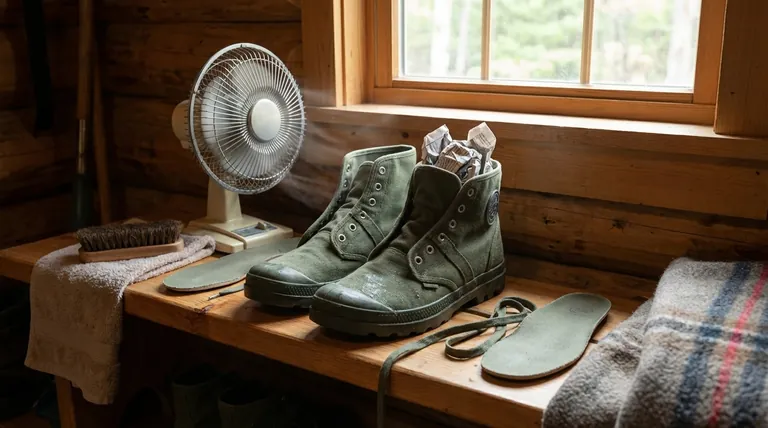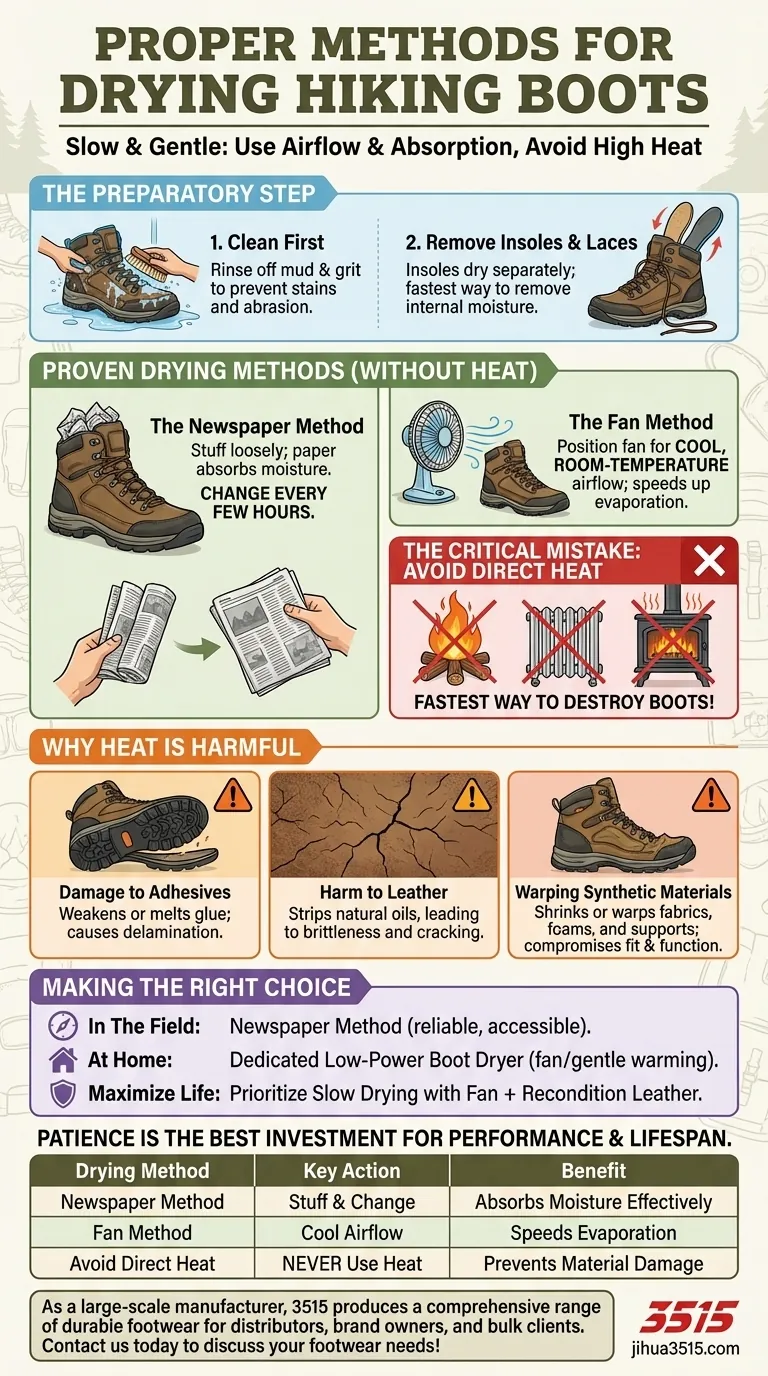The proper way to dry hiking boots is slowly and gently, using airflow and moisture-absorbing materials instead of high heat. The first step is to always remove the insoles and laces to allow them to dry separately. Then, use a fan or stuff the boots with newspaper to gradually draw the moisture out at room temperature.
The single most important rule for drying hiking boots is to avoid direct heat. While slower, methods that rely on airflow and absorption preserve the adhesives and materials that hold your boots together, ensuring their longevity and performance.

The Preparatory Step: Clean and Disassemble
Before you begin drying, taking a moment to prepare the boots ensures a more effective and thorough result.
Why Cleaning First Matters
Drying boots caked in mud can trap abrasive grit and set stains. A quick rinse and scrub with a boot brush and mild soap will prevent this and extend the life of the materials.
Always Remove the Insoles
Insoles act like sponges deep inside your boot. Removing them and drying them separately is the fastest way to get moisture out of the boot's interior and allows both components to dry completely.
Proven Drying Methods (Without Heat)
Patience is the key. These methods safely remove moisture without compromising the boot's construction.
The Newspaper Method
Stuffing your boots loosely with newspaper is a classic, effective technique. The paper absorbs moisture directly from the boot's inner materials.
For this to work well, you must change the newspaper every few hours as it becomes saturated.
The Fan Method
Positioning a small fan to blow cool, room-temperature air into or over the opening of the boots dramatically speeds up evaporation. This is one of the fastest and safest methods available.
Do not use a fan that has a heating element. Simple, cool airflow is all you need.
The Critical Mistake: Why You Must Avoid Direct Heat
It can be tempting to place boots near a campfire, radiator, or wood stove for a quick result, but this is the fastest way to destroy them.
Damage to Adhesives
Modern hiking boots are held together by specialized adhesives that are sensitive to high temperatures. Direct heat can weaken or melt this glue, causing the sole to delaminate or other components to separate.
Harm to Leather
Heat strips the natural oils from leather, causing it to become brittle, dry, and prone to cracking. This will permanently weaken the material and ruin the boot's fit.
Warping Synthetic Materials
The synthetic fabrics, foams, and support structures in many boots can shrink, warp, or lose their shape when exposed to intense heat, compromising both comfort and function.
Making the Right Choice for Your Goal
Select your drying method based on your situation and equipment.
- If your primary focus is drying boots in the field: The newspaper method is your most reliable and accessible option; just be sure to swap out the paper.
- If your primary focus is consistent drying at home: A dedicated, low-power boot dryer that uses only a fan or very gentle warming is an excellent investment.
- If your primary focus is maximizing the life of your boots: Always prioritize slow drying with a fan and recondition full-grain leather once it's fully dry to restore its natural moisture.
Patience in drying your boots is the best investment you can make in their performance and lifespan.
Summary Table:
| Drying Method | Key Action | Benefit |
|---|---|---|
| Newspaper Method | Stuff boots, change paper every few hours | Absorbs moisture effectively, no heat required |
| Fan Method | Use cool airflow directed into boots | Speeds evaporation, preserves boot materials |
| Avoid Direct Heat | Never use radiators, fires, or dryers | Prevents adhesive failure and material damage |
As a large-scale manufacturer, 3515 produces a comprehensive range of durable footwear for distributors, brand owners, and bulk clients. Whether you need reliable hiking boots built to withstand proper care or other types of shoes and boots, our production capabilities ensure top quality and consistency. Contact us today to discuss your footwear needs and benefit from our expert manufacturing solutions!
Visual Guide

Related Products
- Factory-Direct Wholesale Canvas Boots with High-Traction Rubber Soles
- Wholesale High-Traction Camo Boots - Custom Manufacturer for Brands
- High Performance Fire-Retardant Waterproof Safety Boots
- Premium Wholesale Waterproof Safety Boots High Performance Protection for Industrial Markets
- Wholesale Safety Footwear Manufacturer for Bulk & Custom OEM Orders
People Also Ask
- Why are rubber soles beneficial in cold-weather boots? Superior Traction & Waterproofing
- What types of work environments are hiker-style rubber outsoles best for? Ideal for Outdoor & Industrial Safety
- What is a vulcanized sole? Discover the Secret to Superior Flexibility and Grip
- What role do slip-resistant rubber materials play in safety shoes? Ensuring Grip and Stability in Hazardous Workplaces
- What factors determine the slip resistance of rubber-soled shoes? Tread, Compound & Design Explained



















